But
for Yale
University Press editor Charles Grench, who led a staff
of five editors in editing the thirteen-hundred-page book, the
most memorable aspect of his involvement with the project came
when he accompanied Lamar to the Cowboy
Hall of Fame in Oklahoma City.
“I
walked into the elevator, and there was this tall guy in a Western-style
leisure suit,” says Grench. “The door closed, and
he said something to his wife. And the hair just stood up on
the back of my neck. I would have known that voice anywhere.”
Grench
drops to a whisper.
“It
was Clayton Moore–the Lone
Ranger.”

Howard
Lamar shares Grench’s fascination with the West, “the
most American part of the country,” and his awe for its
legends.
“I’m
a dude turned Westerner,” the dean of frontier scholarship
says from his home in New Haven, Connecticut.
Born
on an Alabama cotton plantation, Lamar graduated from Emory
College in 1945 and received his master’s and Ph.D. degrees
from Yale, where he has spent most of his academic career. He
is perhaps best known at Emory for his service as chair of an
external committee of educators that helped define the University’s
path to preeminence in the years following the 1979 Woodruff
gift.
Lamar
says the romance of the West first lassoed him as he watched
Tom Mix and Gene Autry serials on long-ago Saturdays in his
hometown of Tuskeegee. He was drawn in by “the [triumph]
of justice over injustice, the code of honor, and the sheer
action, . . . even though three-quarters of the action is due
to the horse.”
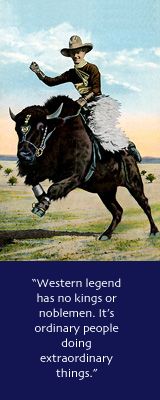 Later,
the scholar Lamar would recognize the movie cowboy as the archetypal
American, “young, a man of action, in control.”
Later,
the scholar Lamar would recognize the movie cowboy as the archetypal
American, “young, a man of action, in control.”
The
siren song of Western mythology, first heard in childhood, has
remained as alluring to him as it has to millions of his countrymen.
“One
wishes for a romantic past, and that’s where the legends
begin, Western legend has no kings or noblemen. It’s ordinary
people doing extraordinary things. You have a large congress
of pioneer heroes.”
Lamar’s
comprehensive reference is chock-full of such heroes: Cochise,
Annie Oakley, Davy
Crockett, Daniel
Boone. In entries that range from A (A&M colleges) to
Z (Zuni
Indians). The New Encyclopedia of the American West also
recounts historic events, enduring myths, cultural phenomena,
and such larger-than-life concepts as Manifest Destiny.
“The
dominating theme in American history is geographic expansion.
The idea that there was ‘another West’ out there was
a consuming passion. It meant there was a second chance. . .
. The West was a synonym for the future until the end of the
twentieth century. . . . Every state in the union in some way
had a kind of Western experience as the frontier moved across
the country.”
Lamar’s
fascination with Western legends was nurtured at Emory by professors
who were legends in their own right: J. Harvey Young and the
late Prentice Miller. He continued to pursue his interests as
a graduate student in history at Yale, where an adviser told
him, “Young man, go west for your dissertation.”
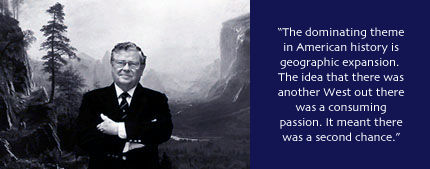
Serendipitously,
New Yorker William Robertson Coe, a wealthy “professional
buff” who’d bought Buffalo
Bill Cody’s ranch in Wyoming, had recently enriched
Yale’s Western studies department with a vast collection
of material including diaries, maps, newspaper articles, letters
signed by famous figures, and a trove of original Western art.
He also endowed the collection with a budget that made Yale
one of the four top sources for Western research materials in
the country. Lamar found the collection had “a friendly
curator,” and soon he had his dissertation subject: frontier
politics in the Dakotas.
In
the summer of 1951, Lamar took a three-month trip to explore
the Black
Hills country. Realizing that the story of the West offered
“a window on American history,” he found more than
a dissertation subject–he found his life’s work. “I
fell in love with the West,” he says.
After
Yale offered him a Western seminar to teach, he says, “I
went back every summer.” His dissertation was published
in 1956 and his teaching duties grew.
By
the time John M. Faragher arrived at Yale in 1971, Lamar’s
classes had become legendary. Faragher says his first Lamar
lecture “knocked my socks off.” The subject–pioneers’
recollections of the Overland Trail and how memory highlighted
some experiences and hid others–became Faragher’s
dissertation topic, and later, his first book. Another former
student, Clyde A. Milner II, now executive editor of the Western
Historical Quarterly and a professor of history at Utah State
University, says Lamar’s “Survey of the American West”
course was “a tour de force, famous at Yale. Students flocked
to it.”
“I
trained sixty graduate students and Ph.D. candidates,”
says Lamar. “Many are now teaching in the West.” Over
the span of his career, he would also publish six more books
about the region.
One
of those works was an ambitious project launched in 1965 and
published in 1978 as The Reader’s Encyclopedia of the West,
which Library Journal praised as not only “a useful reference
tool, but [also] a delight to browse in.” Almost immediately,
Lamar started to update it.
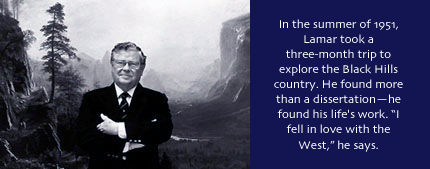
By
1991, Lamar was immersed in what would become The New Encyclopedia
of the American West. Yale University Press had bought the rights,
and Lamar estimated it would take about two years to revise
and expand the volume. Circumstances conspired to interfere
with that schedule, however, when in 1992 Lamar became acting
president of Yale after a leadership crisis. (Lamar was retroactively
given the full title of president as a measure of gratitude
for his term in office.)
In
1994, Lamar again was able to take up work on the book. The
scope of the project was daunting. He contacted six hundred
scientists, archivists, geologists, and cultural historians,
three hundred of whom became contributors. Fifteen graduate
students did legwork in the library, updated old material, and
contributed some of the twenty-four-hundred entries. Lamar wrote
about one hundred essays himself and revised another five hundred.
Every word of the original work was reviewed and updated, and
more history of the urban, twentieth-century West was added.
At
Yale University Press, Charles Grench assigned five editors
to work on the five-thousand-page manuscript. Photos were supplied
from repositories around the country and contemporary Western
photographers. The Coe collection provided scrapbooks, stereopticons,
and Carleton Watkins photography.
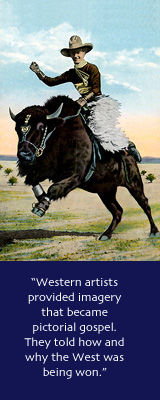 “Artists
and photographers traveled with explorers, and printed these
images very inexpensively,” says Lamar. “People had
a way of seeing the West from the earliest days. The romantic
images of the period tell us a lot about the times.”
“Artists
and photographers traveled with explorers, and printed these
images very inexpensively,” says Lamar. “People had
a way of seeing the West from the earliest days. The romantic
images of the period tell us a lot about the times.”
“Western
artists provided imagery that became pictorial gospel,”
says Peter Hassrick, professor of art history at the University
of Oklahoma. “They told how and why the West was being
won.”
Published
in October 1998, the book received strong reviews and has sold
around twelve thousand copies.
“It
seems to me to be a kind of representation of the best work
we’re able to do,” says Grench.
Still
there were objections. Texas novelist Larry McMurtry wrote a
review grousing about the lack of an entry for chili.
Others,
however, have weighed in about the book’s larger contributions
to the body of knowledge about the West. “This book offers
you the opportunity to check the facts,” says Faragher.
“History has a peculiar power, in that it purports to tell
the truth. People are hungry for that, especially in this age
of TV and the Internet.”
More
significantly, the New Encyclopedia incorporates recent
scholarship on the contributions of women, minorities, and native
people while building on previous historians’ groundwork.
“Howard’s
encyclopedia is a benchmark of all the great works,” says
Milner. “It’s in touch with not only the most recent
work, but grand older traditions.” He notes that Western
scholars’ differing philosophies have created heated debates:
“It’s not one big happy bunkhouse.”
The
book “tracks how much the field has changed in the last
generation,” says Lamar protégé Faragher,
who went on to publish a prizewinning biography of Daniel Boone
and later took his mentor’s teaching post as Arthur Unobskey
Professor of American History. The emphasis on ethnic traditions
and Indian and oral history “stands as a monument to new
scholarship.”
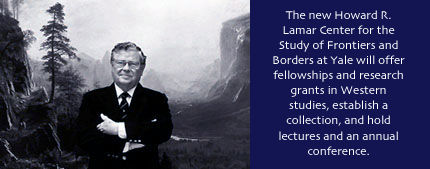
Perhaps
the only subject to bring higher praise than Lamar’s book
is Lamar himself.
“I’ve
known a lot of scholars,” says Milner. “Many are good
people. Few can match Howard for his kindness and decency.”
The
new Howard R. Lamar Center for the Study of Frontiers and Borders
will offer fellowships and research grants on Western studies,
establish a collection, and hold lectures and an annual conference.
Says
Faragher, “We’d like to make some waves and keep Howard’s
name before the public.”
Krista
Reese is a frequent contributor to Emory Magazine.